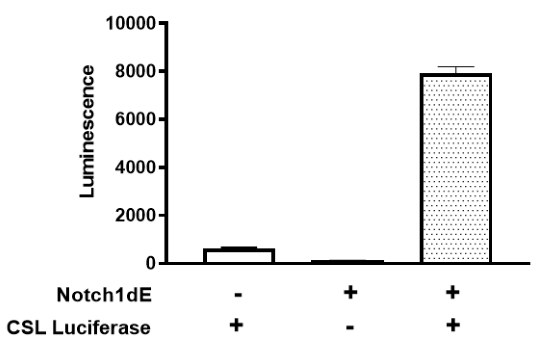78747
Notch1dE Lentivirus
BPS Bioscience
DESCRIPTION
Notch1dE Lentiviruses are replication incompetent, HIV-based, VSV-G pseudotyped lentiviral particles that are ready to transduce most mammalian cells, including primary and non-dividing cells. These lentiviruses express a truncated human Notch1 construct (Notch1dE) in which the entire extracellular domain was deleted. The lentiviruses also contain a puromycin selection marker (Figure 1). Once expressed in a cell line of interest, Notch1dE is cleaved by γ-secretase, resulting in the constitutively active intracellular domain of Notch (NICD). NICD translocates to the nucleus, binds to the transcription factor CSL (CBF1/RBPJκ/Suppressor of Hairless/Lag-1) and activates transcription of Notch1-responsive genes.
When used in combination with CSL (CBF1/RBP-Jk) Luciferase Reporter Lentiviruses (BPS Bioscience #78746), NICD activates the CSL (CBF1/RBPJκ/Suppressor of Hairless/Lag-1) responsive elements, inducing luciferase expression.
DETAILS
- Notes: To generate a Notch1dE stable cell line, remove the growth medium 48 hours after transduction and replace it with fresh growth medium containing the appropriate amount of puromycin (as pre-determined from a killing curve, FAQs (bpsbioscience.com)) for antibiotic selection of transduced cells, followed by clonal selection. Biosafety: The lentiviruses are produced with a SIN (self-inactivation) lentivector which ensures self-inactivation of the lentiviral construct after transduction and after integration into the genomic DNA of the target cells. None of the HIV genes (gag, pol, rev) will be expressed in the transduced cells, as they are expressed from packaging plasmids lacking the packing signal and are not present in the lentivirus particle. Although the pseudotyped lentiviruses are replication-incompetent, they require the use of a Biosafety Level 2 facility. BPS Bioscience recommends following all local federal, state, and institutional regulations and using all appropriate safety precautions Troubleshooting Guide: Visit bpsbioscience.com/lentivirus-faq for detailed troubleshooting instructions. For all further questions, please email support@bpsbioscience.com.
- Shiptemp: -80°C (dry ice)
- Warnings: Avoid freeze/thaw cycles
- Category: Cell Signaling/Lentivirus
- Background: The Notch signaling pathway controls cell fate decisions in vertebrates and invertebratesʹ tissues and is involved in embryonic development, tissue homeostasis, and regulation of the immune and angiogenic systems. Notch signaling is triggered through the binding of a transmembrane ligand, present in opposing cells, to one of the four existing Notch transmembrane receptors (Notch1/Notch2/Notch3/Notch4). This results in proteolytic cleavage of the Notch receptor, releasing the constitutively active intracellular domain of the Notch receptor (NICD). NICD translocate to the nucleus and associates with the transcription factor CSL (CBF1/RBPJκ/Suppressor of Hairless/Lag-1) and coactivator Mastermind to turn on the transcription of Notch-responsive genes. Dysfunction of Notch signaling has severe consequences, including developmental pathologies or cancer (such as T cell acute lymphoblastic leukemia, T-ALL, and urothelial bladder cancer). The use of Notch inhibitors, mainly gamma-secretase inhibitors, as a cancer therapy option and in the regeneration of tissues is ongoing. Further studies will allow us to have a deeper understanding of Notch signaling and will benefit future therapeutic approaches.
- References: Lu F.M., et al., 1996 Natl. Acad. Sci. USA 93(11): 5663-5667. Kanungo J., et al., 2008 Neurochem. 106: 2236-48. Cao L. et al., 2023 Blood Adv. 1182/bloodadvances.2023010380
- Description: Notch1dE Lentiviruses are replication incompetent, HIV-based, VSV-G pseudotyped lentiviral particles that are ready to transduce most mammalian cells, including primary and non-dividing cells. These lentiviruses express a truncated human Notch1 construct (Notch1dE) in which the entire extracellular domain was deleted. The lentiviruses also contain a puromycin selection marker (Figure 1). Once expressed in a cell line of interest, Notch1dE is cleaved by γ-secretase, resulting in the constitutively active intracellular domain of Notch (NICD). NICD translocates to the nucleus, binds to the transcription factor CSL (CBF1/RBPJκ/Suppressor of Hairless/Lag-1) and activates transcription of Notch1-responsive genes. When used in combination with CSL (CBF1/RBP-Jk) Luciferase Reporter Lentiviruses (BPS Bioscience #78746), NICD activates the CSL (CBF1/RBPJκ/Suppressor of Hairless/Lag-1) responsive elements, inducing luciferase expression.
- Formulation: The lentivirus particles were produced in HEK293T cells. They are supplied in cell culture medium containing 90% DMEM + 10% FBS. Virus particles can be packaged in custom formulations by special request, for an additional fee.
- Supplied As: Two vials (500 µl x 2) of lentivirus at a titer ≥107 TU/ml. The titer varies with each lot; the exact value is provided with each shipment.
- Unspsc Code: 41106621
- Unspsc Name: Virus mediated expression vectors or kits
- Applications: Monitor Notch signaling pathway activity, when used in combination with the CSL (CBF1/RBP-Jk) Luciferase Reporter Lentivirus (BPS Bioscience #78746). Generate Notch1dE-expressing cell pools or stable cell lines by puromycin selection.
- Product Type: Lentivirus
- Biosafety Level: BSL-2
- Related Products: 60652, 79503, 79578
- Storage Stability: Lentiviruses are shipped with dry ice. For long-term storage, it is recommended to store the lentiviruses at -80°C. Avoid repeated freeze-thaw cycles. Titers can drop significantly with each freeze-thaw cycle.
- Scientific Category: Cell Signaling Pathway

